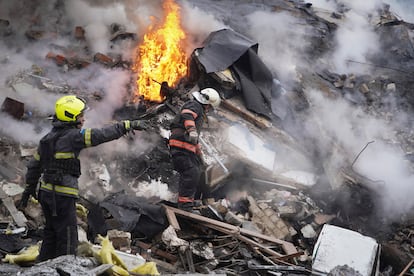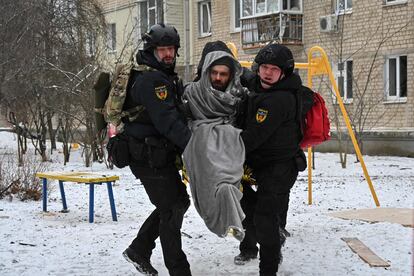Russia uses new tactic to bomb Ukraine and overcome its air defenses
Moscow’s simultaneous attack with ballistic and cruise missiles from different regions has led to seven deaths and more than 60 injuries

Russia bombed on Tuesday three cities in Ukraine, killing seven civilians and leaving more than 60 injured. It would be just another attack by the invader’s air forces were it not for the number of rockets launched — a total of 41 — and the tactics used — a combination of cruise and ballistic missiles fired in the same operation from five different Russian provinces.
Since last summer, the Russian army has been building up a vast arsenal of drone bombs and missiles. Now, it is using these weapons to punish the Ukrainian rear, but it’s changing its strategy. The result was seen on Tuesday: the Ukrainian Air Forces shot down 21 of the 41 rockets fired, which were aimed at Kyiv. Half of the enemy targets were intercepted — below the average 80% effectiveness that was achieved in 2023. Similar results were seen on January 8: Russia fired 59 projectiles, including missiles and Shahed “kamikaze” drones, with 40% intercepted.
The city hardest hit by Tuesday’s attack was Kharkiv, just 25 miles from the Russian border, where five people in apartment buildings were killed. Another 40 people were injured. In Kyiv, Russia’s strikes killed one woman and injured more than 20 people. In Pavlohrad, an important logistics hub in the Dnipro province near the Donetsk front, another woman was killed.
Russia fired the missiles from the ground and from bomber planes that took off from five different regions of Russia. In contrast to the tactic seen in previous months, in which rockets are launched in spaced-out waves, Tuesday’s attack was almost simultaneous, said Mikhail Shamanov, the spokesperson of the Kyiv military administration.

Russia first fired Kh-101 and Kh-555 cruise missiles from the Caspian Sea. When they were over the target’s airspace at just 6:30 a.m., Iskander ballistic missiles were fired from the Russian provinces of Belgorod and Voronezh. The Iskander — which can travel faster than the speed of sound — reached Kyiv’s airspace when Ukraine’s air defenses were shooting down the cruise missiles, Shamanov told local news. At that moment, the EL PAÍS journalist on the ground was able to hear several successive explosions coming from different locations in Kyiv.
The anti-aircraft system in Kyiv — the most protected city in Ukraine — stopped the near-simultaneous attack, but this was not the case for Kharkiv. Its proximity to Russian territory makes it more vulnerable, but this time, it was not only struck by the usual S-300 and S-400 missiles fired from neighboring Belgorod, it was also hit the Iskander and the Kh-22 cruiser weapons, launched from bombers in the Bryansk and Oryol provinces. This is what was responsible for most of the damage in the city.
Alarm in Poland
The first warning of Russia’s new bombing strategy came on December 29. On that day, 122 missiles were fired at Ukrainian cities, but 70% of them were shot down. The attack was launched from different Russian regions, and in different waves. Thirty-nine people died and more than 160 were wounded. The airstrike came from multiple locations — a Russian missile even flew over 25 miles of NATO member Poland’s airspace. Polish fighter jets took off in combat mode Tuesday morning in case Russia would once again invade its airspace, said the Polish Armed Forces.
In recent months, Russia has also introduced the tactic of bombing the same target with swarms of Shahed drones that are launched from different directions. This practice makes it more difficult for the anti-aircraft guns to coordinate the defense.
One of the goals of Russia’s strikes is to deplete Ukraine’s anti-aircraft ammunition. The Ukrainian Air Force warned on January 8 that its shortage of U.S. Patriot missiles was jeopardizing the effectiveness of its air defense. Patriot missiles are the main weapon Ukraine uses in its anti-aircraft defense system, followed by the German Iris-t and the Norwegian Nasams. But in the United States, the Republican Party is blocking the White House from approving a new military aid package for Ukraine. As a result, Ukraine’s resources are being stretched to the limit. Kyiv’s troops have moved to defensive positions on virtually the entire war front, and even slowly retreated on the front in the Donetsk and Kharkov provinces.
Sign up for our weekly newsletter to get more English-language news coverage from EL PAÍS USA Edition
Tu suscripción se está usando en otro dispositivo
¿Quieres añadir otro usuario a tu suscripción?
Si continúas leyendo en este dispositivo, no se podrá leer en el otro.
FlechaTu suscripción se está usando en otro dispositivo y solo puedes acceder a EL PAÍS desde un dispositivo a la vez.
Si quieres compartir tu cuenta, cambia tu suscripción a la modalidad Premium, así podrás añadir otro usuario. Cada uno accederá con su propia cuenta de email, lo que os permitirá personalizar vuestra experiencia en EL PAÍS.
¿Tienes una suscripción de empresa? Accede aquí para contratar más cuentas.
En el caso de no saber quién está usando tu cuenta, te recomendamos cambiar tu contraseña aquí.
Si decides continuar compartiendo tu cuenta, este mensaje se mostrará en tu dispositivo y en el de la otra persona que está usando tu cuenta de forma indefinida, afectando a tu experiencia de lectura. Puedes consultar aquí los términos y condiciones de la suscripción digital.
More information
Archived In
Últimas noticias
Most viewed
- Sinaloa Cartel war is taking its toll on Los Chapitos
- Oona Chaplin: ‘I told James Cameron that I was living in a treehouse and starting a permaculture project with a friend’
- Reinhard Genzel, Nobel laureate in physics: ‘One-minute videos will never give you the truth’
- Why the price of coffee has skyrocketed: from Brazilian plantations to specialty coffee houses
- Silver prices are going crazy: This is what’s fueling the rally










































